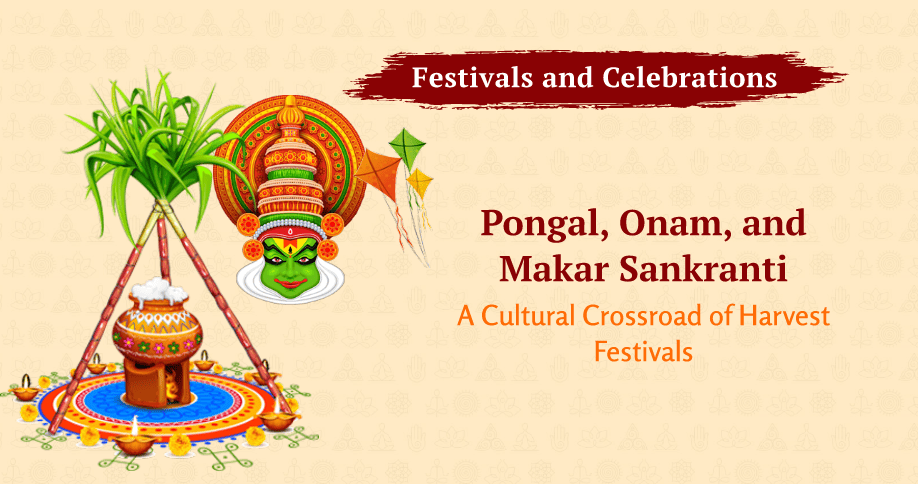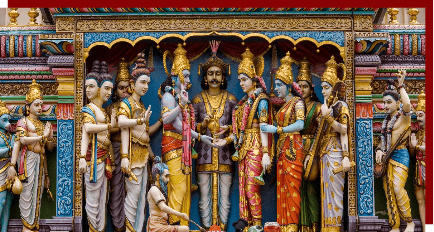Pongal, Onam, And Makar Sankranti
A Cultural Crossroad Of Harvest Festivals
Harvest festivals have been an integral part of human civilization, celebrating nature’s bounty and agricultural success. In India, where agriculture forms the backbone of the economy, these festivals hold deep cultural and spiritual significance. Among the many vibrant celebrations, Pongal, Onam, and Makar Sankranti stand out as distinct yet interconnected harvest festivals. Rooted in tradition, these festivities reflect gratitude, unity, and the joy of abundance.
1. The Essence Of Harvest Festivals In India
Harvest festivals symbolize the gratitude of farmers towards nature for a successful crop yield. These celebrations not only revolve around agricultural prosperity but also foster a sense of community and shared joy. Pongal, Onam, and Makar Sankranti are prime examples of how India’s diverse cultural tapestry celebrates the universal spirit of thanksgiving.
2. Pongal: The Pride Of Tamil Nadu
2.1 What Is Pongal?
Pongal, celebrated in Tamil Nadu, is a four-day festival that coincides with the Tamil month of Thai (January–February). The word “Pongal” translates to “boiling over,” signifying abundance and prosperity.

2.2 The Four Days Of Pongal
Bhogi Pongal
Thai Pongal
Mattu Pongal
Kaanum Pongal
A day for family reunions and outings.
2.3 Rituals And Traditions
The highlight is cooking sweet Pongal, a dish made from rice, jaggery, and milk, and letting it overflow in a pot, symbolizing prosperity. Houses are decorated with colorful kolams (rangoli), and farmers honor their cattle with garlands and paint.
3. Onam: Kerala’s Grand Carnival
3.1 The Legend Behind Onam
Onam is rooted in the mythological story of King Mahabali, whose reign is celebrated for equality and prosperity. According to legend, Lord Vishnu, in his Vamana avatar, blessed Mahabali to return once a year, marking the occasion of Onam.
3.2 The Ten-Day Celebration
Onam spans ten days, with the most prominent being Thiruvonam. Each day has unique rituals, from Pookalam (floral rangoli) competitions to boat races and Onam Sadhya—a grand vegetarian feast served on banana leaves.

3.3 Highlights Of Onam
Vallamkali (Boat Races)
The exhilarating snake boat races symbolize teamwork and vigor.
Pulikali (Tiger Dance)
Performers painted as tigers dance to the rhythm of drums.
Kathakali Performances
Traditional dance-drama enacting tales from Indian epics.
4. Makar Sankranti: A Pan-Indian Festival
4.1 The Astronomical Significance
Makar Sankranti, unlike most Indian festivals, follows the solar calendar and marks the Sun’s transition into the Capricorn (Makara) zodiac. This day signifies longer days and the end of winter.

4.2 Regional Variations Of Makar Sankranti
Andhra Pradesh
Maharashtra
Punjab
Uttar Pradesh

4.3 Key Rituals
Flying kites is a major attraction during Makar Sankranti. The skies burst with vibrant colors as people celebrate freedom and joy. Preparing and sharing sesame-based sweets symbolizes unity and warmth.
5. Common Threads: Unity In Diversity
Despite being region-specific, Pongal, Onam, and Makar Sankranti share common themes:
Gratitude: Acknowledging nature’s role in sustenance.
Community Bonding: Festivals bring families and neighbors together.
Food: Each festival showcases unique culinary traditions, reflecting the region’s agricultural richness.
6. Culinary Delights Of Harvest Festivals
6.1 Pongal’s Sweet And Savory Flavors

Sweet Pongal
A Rice And Jaggery Pudding.

Ven Pongal
A Savory Dish Flavored With Pepper And Cumin.

Onam’s Onam Sadhya
An Elaborate Feast With Over 25 Dishes, Including Avial, Sambhar, And Payasam.
6.2 Sankranti’s Til-Based Sweets

Tilgul
Sesame-Jaggery Candies.

Puran Poli
Sweet Stuffed Flatbread.
7. Symbolism In Decorations
Kolams : in Pongal reflect creativity and devotion.
Pookalam : in Onam signifies unity with nature.
Kite flying : during Makar Sankranti represents freedom and aspirations.
8. Economic Impact Of Harvest Festivals
Harvest festivals boost local economies through:
Increased sales of festival-related products like decorations and food items.
Tourism as people flock to witness iconic events like Onam’s boat races.
9. Environmental Connection
These festivals emphasize eco-friendly practices, from using natural materials in decorations to avoiding wastage of food.
10. Conclusion: Celebrating India’s Cultural Wealth
Pongal, Onam, and Makar Sankranti are more than just celebrations; they are vibrant reminders of India’s deep connection to agriculture, nature, and community. While each festival has its unique charm, their shared values of gratitude, unity, and joy make them timeless traditions that continue to enrich India’s cultural heritage. Let us cherish and preserve these festivals, ensuring their legacy for generations to come.



